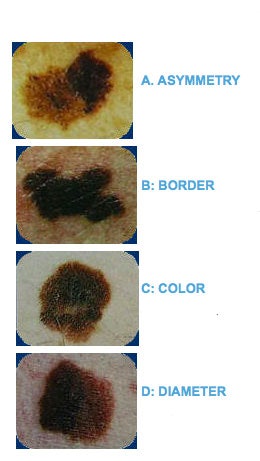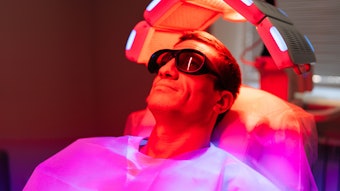
As a dermatologist, one of my most common responsibilities is to perform skin cancer screenings for my patients. I often start out by asking, “What brought you in to the office today? Have you noticed anything new or changing on your skin?”
It may come as a surprise to learn how often a patient will tell me that her stylist or esthetician noticed an unusual mole on her and suggested that she visit a dermatologist. Or that a massage therapist noticed a strange growth on his back and referred him to a dermatologist for evaluation.
You don't have to go to medical school to know how to spot the warning signs of cancer.
Estheticians, massage therapists and other salon professionals are in a unique position to take note of unusual growths on their client’s skin and start an important conversation that may ultimately save a client’s life. Dermatologist Neville Davis, M.D., wrote, “Melanoma writes its own message in the skin with its own ink, and it is there for all of us to see.” You don't have to go to medical school to know how to spot the warning signs of skin cancer. These warning signs sit right on the skin’s surface, and a skin care professional is in a terrific position to be able to recognize them and save a life.
Skin Cancer Types
Skin cancer is by far the most common type of cancer around the world. Most (but not all) skin cancers are related to exposure to ultraviolet (UV) light from the sun or from artificial light sources like tanning beds. There are three major types of skin cancer: basal cell carcinoma (BCC), squamous cell carcinoma (SCC) and melanoma.
Estheticians, hair stylists, nail technicians and massage therapists can play an important role in recognizing all three types of skin cancer. Which is why the Melanoma Foundation of New England’s Skinny On Skin program is a critical educational tool for beauty industry.
BCC. BCC is the most common form of skin cancer. It often arises on sun-exposed areas of the body. The face, ears, scalp and the back of the neck are common locations. BCC shows up on the skin as pearly or translucent pink bumps on the surface of the skin. BCC bleeds easy and does not heal well.
When a client tells you that they bumped their head three months ago but the site never seemed to heal, this is a good hint that should prompt you to look more closely. BCC is curable by surgical removal, but the results can be disfiguring.
SCC. SCC is often scalier and crustier bumps that also show up on sun exposed areas of the body. These itchy bumps may bleed easily and commonly appear on the head and neck, ears, forearms and hands. A client may report that they have an itchy, tender bump on their scalp and ask that you be careful around the site to avoid irritating it further. With a quick look, a skin care professional can confirm the presence of a suspicious spot, open up a conversation with the client and refer them to a doctor for more precise diagnosis.
Melanoma. Melanoma is less common than BCC or SCC, but it is potentially deadly if not caught early. Melanoma can occur at any age, but it is becoming more and more common among young women as a result of tanning bed use. Even a single episode of sunburn, especially before 18 years old, can cause damage to the skin that will later show up as melanoma.
Melanomas on the scalp can be among the most deadly form of skin cancer, and skin care professionals can play a crucial role in recognizing them early. If caught in its early stages, melanoma is highly curable. This highlights the importance of early skin cancer detection, and skin care professionals can play an important role in this.
Estheticians and massage therapists often see their clients on a regular basis and spend much of their visit looking at the areas that are at risk for melanoma. The comfortable, friendly relationship a spa professional frequently has with a client offers the perfect setting for an alert esthetician or massage therapist to encourage the client to seek further medical attention for a potentially deadly skin cancer. In fact, a 2011 study published in JAMA Dermatology showed that, even though very few hair professionals had received any formal skin cancer education, many stylists already informally examine the skin of the head and neck and offer skin care advice as part of their profession. This study showed that spa professionals could be armed with confidence from a skin cancer educational session.
Supplement this knowledge with customer information cards that can be offered to clients, and suddenly estheticians and massage therapists are in a terrific position to become health advisors for skin cancer prevention and early detection.
The ABCDEs of Melanoma
Knowing a few simple warning signs of melanoma allows spa professionals to be instrumental in finding early skin cancers and helping clients get help early. Look for the ABCDEs of melanoma.
 A: Asymmetry
A: AsymmetryBenign, normal moles should be symmetric. Your attention may be drawn to moles where one half looks very different from the other half. If you mentally draw a line through the middle of a mole, the two sides should match. If they do not, this asymmetry may be an early warning sign for melanoma.
B: Border irregularity
Benign moles have a smooth, even border. Your attention might be drawn to a mole with a jagged border. A notched, irregular, blurred or scalloped edge should alert you to the possibility of an early melanoma.
C: Color
There is no single color that is worrisome. Some patients have very deeply pigmented moles, while others might be a light reddish brown. The key is that a mole should be evenly colored throughout. A single mole that has multiple colors within it may be a signal for an early melanoma.
D: Diameter
Benign moles are usually less than 6 mm in size. Moles that are larger moles than a pencil eraser size are thought to be more worrisome for melanoma. Spotting a large mole may alert a spa professional to the presence of an early melanoma.
E: Evolution
Benign moles tend to look the same over time. If a mole starts to evolve or change in size, shape, symptoms, color or elevation, this may be an early sign of melanoma.
Estheticians who see clients on a regular basis are in an excellent position to notice a changing mole that may be an early melanoma. Armed with the knowledge of what an early melanoma looks like, what’s the next step if you spot a suspicious spot on a client’s skin?
Some estheticians worry about turning a relaxing spa or salon experience into a scary one for their clients. Others worry that they are not health professionals and are not in a position to truly diagnose a skin cancer. Both of these concerns are very real, but there are some tools an esthetician can use to keep their clients informed, while still maintaining the soothing, trusting setting of a spa or salon visit.
The ABCDs of Client Communication
Here is another ABCD list that may be useful in approaching a client about skin cancer concerns that arise during your visit:
A: Advise
Let your clients know that you are a beauty advisor and that beautiful skin is healthy skin. Let them know that you have skill and expertise in evaluating skin health and can offer them advice about anything you might see. Your client will be less surprised if you bring up something you observe during their visit.
B: Be a Role Model
Let your clients know how to protect their skin to keep it healthy. Talk to them about sunscreens, sun protectio, and encourage them to have a yearly full skin examination with their dermatologist.
C. Cell Phone Camera
Many clients may never have seen the spot you have spotted on their skin. Spa professionals are in a position to see skin cancers that are hidden from view for most clients, like the back of the neck, the scalp or behind the ears. Cell phone cameras offer a great opportunity to snap a photo and show it to your client so that they know what you have observed on their skin. They can take this photo to their dermatologist to illustrate your concerns.
D: Don’t Diagnose
You have the tools now to detect suspicious spots on the skin, but you are still not in a position to diagnose skin cancer. Telling your clients that you notice something suspicious or unusual is terrific. Telling them that they have skin cancer is not. Offering your concerns along with an informational pamphlet and a recommendation to see a dermatologist allows you to maintain your professional, soothing relationship without overly frightening your client.
Save a Life
Far more people visit their estheticians, massage therapists and other professionals on a regular basis than their dermatologist. You see your clients every few months and build a trusting relationship over time. This puts you in a unique position to save your client's life by spotting an unusual spots on their skin that may be early skin cancers and directing them to the appropriate professional for treatment.










